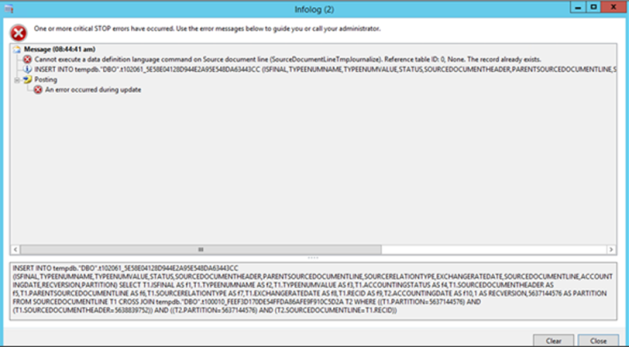cannot create a data definition language command on “source document line” : Accounting distribution
April 17, 2018 Leave a comment
error “cannot create a data definition language command on “source document line””
In one of the client we had the requirement to always post the Pending vendor invoice on today’s date, regardless of when it was created. so we did the simple customization to update the TransDate before code initiate the posting process.
vendInvoiceInfoTable.selectForUpdate(true);
vendInvoiceInfoTable.TransDate = today();
vendInvoiceInfoTable.update();
But for this requirement is not that simple, somehow it is not updating the Accounting distribution and keeping the entries on older date in AccountingDistribution table, hence causing the error which is title of this blog.
After lots of investigation i reached to the conclusion, and this small job help me finding the cause and fixing it by creating the new Accounting Distribution record in today’s date and deleting the older one.
static void VendInvAccDistributionCorrection(Args _args)
{
AccountingDistribution AccountingDistribution, AccountingDistributionCopy;
vendInvoiceInfoLine vendInvoiceInfoLine;
VendInvoiceInfoTable vendinvoiceInfoTable;
select firstonly vendInvoiceInfoTable where vendInvoiceInfoTable.Num == '1234';// todo invoice number to remove the matching
if (vendInvoiceInfoTable.RecId)
{
ttsBegin;
vendInvoiceInfoTable.selectForUpdate(true);
vendInvoiceInfoTable.TransDate = today();
vendInvoiceInfoTable.update();
ttsCommit;
while select vendInvoiceInfoLine
where vendInvoiceInfoLine.TableRefId == vendinvoiceInfoTable.TableRefId
&& vendInvoiceInfoLine.ParmId == vendinvoiceInfoTable.ParmId
{
select firstOnly * from AccountingDistributionCopy order by number desc
where AccountingDistributionCopy.SourceDocumentHeader == vendinvoiceInfoTable.SourceDocumentHeader
&& AccountingDistributionCopy.SourceDocumentLine == VendInvoiceInfoLine.SourceDocumentLine;
AccountingDistribution.SourceDocumentLine = VendInvoiceInfoLine.SourceDocumentLine;
AccountingDistribution.SourceDocumentHeader = vendinvoiceInfoTable.SourceDocumentHeader;
AccountingDistribution.TransactionCurrency = VendInvoiceInfoTable.CurrencyCode;
AccountingDistribution.LedgerDimension = AccountingDistributionCopy.LedgerDimension;
AccountingDistribution.AccountingLegalEntity = AccountingDistributionCopy.AccountingLegalEntity;
AccountingDistribution.MonetaryAmount = AccountingDistributionCopy.MonetaryAmount;
AccountingDistribution.AccountingDate = today();
if (vendInvoiceInfoLine.LineAmount && AccountingDistribution.MonetaryAmount)
{
AccountingDistribution.AllocationFactor = AccountingDistribution.TransactionCurrencyAmount/VendInvoiceInfoLine.LineAmount;
}
else
{
AccountingDistribution.AllocationFactor = 1;
}
AccountingDistribution.AmountSource = DistributionAmountSource::PrimaryAmount;
//axAccountingDistribution.parmMonetaryAmountType(MonetaryAmount::ExtendedPrice);
AccountingDistribution.insertAccountingDistribution(true);
}
delete_from accountingDistribution
where accountingDistribution.SourceDocumentHeader == vendinvoiceInfoTable.SourceDocumentHeader
&& accountingDistribution.AccountingDate != today();
}
else{
info(strFmt('invoice not found in %1 company', curext()));
}
}

 This is Amir Nazim from Karachi Pakistan, having very good experience on Microsoft Dynamics AX and related technologies, currently working as Microsoft Dynamics Ax Sr. Development Engineer and Solution Architect in MBS (Implementation) team.
This is Amir Nazim from Karachi Pakistan, having very good experience on Microsoft Dynamics AX and related technologies, currently working as Microsoft Dynamics Ax Sr. Development Engineer and Solution Architect in MBS (Implementation) team. 
